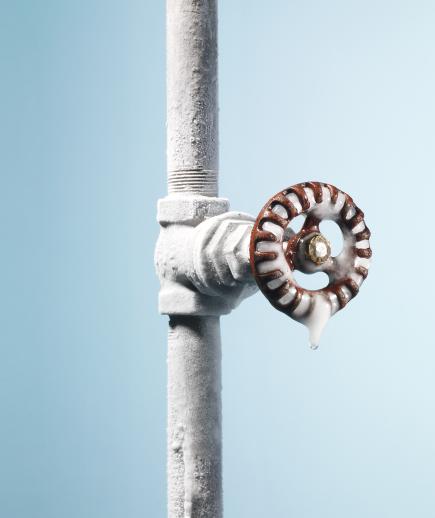 1. Insulate pipes
1. Insulate pipesAny exposed pipe that runs along a wall or is in an unheated area (a basement or a crawl space, for example) is a potential hazard. The water inside can freeze and cause the pipe to burst when temperatures drop below 32 degrees Fahrenheit. “It’s easy to protect them with pipe insulation. Get it at the hardware store—it looks like a giant piece of spaghetti with a slit,” says Lou Manfredini, the host of HouseSmarts. “Cut it to fit the length of the pipe, wrap it around, then secure with duct tape if needed.”
2. Inspect tree branches
Scan your property for branches growing over the house, garage, driveway, or power lines. During a storm, those could come down and cause major damage. Branches rubbing together can also lead to breakage. Look for signs of dead limbs, too: dead leaves that remain attached after the rest of the tree has shed, many smooth areas that are missing bark, or spots where mushrooms have sprouted. If you see anything suspicious, call an arborist for an evaluation.
3. Clean out gutters
If they’re clogged with leaves, the debris can freeze into a big, icy mass, which could get under shingles and damage the roof. Get a tall ladder and work gloves, and scoop out the debris so water can drain. “Make sure you’re comfortable on a ladder and have a buddy with you to help support it,” says Manfredini. A leaf blower can speed things up, but you may still need to use your hands to finish the job. Prefer to call in a handyman? The service typically takes about two hours.
4. Prevent door locks from freezing
If you’ve ever had this problem or you live in a super-cold climate, spray a little powdered-graphite lubricant into each door lock (where the key goes), then turn the key in the lock. The powder (sold at hardware stores) lubricates the pins inside the lock to prevent sticking. Do this once a season.
5. Drain sprinklers
If you have an outdoor sprinkler system, it’s smart to remove any residual water before the first freeze so it doesn’t expand and crack the pipes. Your best bet is to hire an irrigation contractor to blow out the water using compressed air. If you prefer to give it a shot yourself, consult the manufacturer’s website. (Directions vary by system.) Generally the process involves shutting off the water source, then opening the drain valves located at the lowest part of the irrigation system (usually in the basement) to allow water to drain.
6. Cut back perennials
It’s fine to keep some intact. Those with a pretty shape (coneflowers, ornamental grass) look nice even in winter. But most deciduous perennials—plants that shed their leaves annually (like asters, irises, and lilies)—do best with an aggressive trim, says Jennifer G. Horn, a landscape architect in Washington, D.C. Using clippers or a hedge trimmer, cut plants to two to three inches above the ground. Not only does this make your garden look tidier but it also eliminates potential homes for harmful insects, who like to hide out, then surface during spring growth.
7. Mulch flower beds
Sometime before the coldest winter temps hit, add a layer of hardwood mulch to all your flower beds. “Mulching at this time of year helps regulate changes in soil temperature,” says Horn. The mulch acts as insulation, buffering the plants from brutally low temperatures to come. Without it, roots are vulnerable to significant damage and the plants could die.
8. Block drafts
Hold a lit candle along each windowsill and baseboard. See it flicker? That signals a draft—and for each draft that you eliminate, you can increase your home’s energy-efficiency, says Manfredini. For baseboards, clean and dry the area with a paper towel. Then, using white or clear paintable caulking, fill in gaps between the trim and the floor with an even bead. Smooth with a wet finger, then remove the excess with a damp cloth. To seal drafty windows and doors, use weather stripping (around the frame) or window-film kits (over the glass; both available at hardware stores).
9. Get the fireplace cleaned
If you use a wood-burning fireplace more than six times a year, you should have it professionally cleaned and inspected by a certified chimney sweep annually, because built-up creosote and soot can ignite, says Paul Sullivan of the National Association of Home Builders Remodelers. If you almost never use your fireplace or have a gas one (cleaner-burning than wood), an inspection every three years is sufficient.
10. Have the furnace checked
At the beginning of winter, hire an HVAC (heating, ventilation, and air-conditioning) contractor to make sure your furnace or boiler is operating safely and efficiently. “The pro will pull apart the burners, inspect all the contacts and sensors, and replace the filter,” says Manfredini. To keep the appliance running well, inspect the filter monthly (it slides in), and replace it when it turns brown or black. Stick with a pleated version, which has more particle-trapping surface area than a flat filter.




